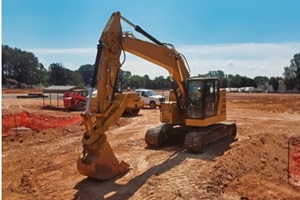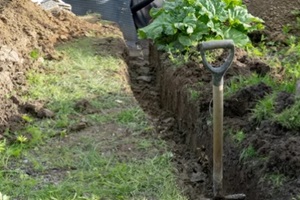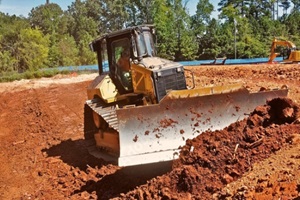 Landscaping has the power to transform ordinary outdoor spaces into picturesque oases, but the foundation of any spectacular yard lies beneath the surface in the art of land grading. This article will explore how effective land grading enhances the visual appeal of your yard while ensuring its long-term health and overall sustainability.
Landscaping has the power to transform ordinary outdoor spaces into picturesque oases, but the foundation of any spectacular yard lies beneath the surface in the art of land grading. This article will explore how effective land grading enhances the visual appeal of your yard while ensuring its long-term health and overall sustainability.
From preventing water damage to creating the perfect canvas for your gardening dreams, land grading is a pivotal step in landscape design.
Whether you’re a gardening enthusiast or a professional landscaper, this guide will provide valuable insights into the techniques, tools, and tips for achieving a perfectly graded yard that marries aesthetic beauty with functional design.
Understanding the Basics of Land Grading
Simply put, land grading is the process of leveling or sculpting a chosen landscape to a desired slope. This process is essential for proper drainage and soil stability, which are key to having a healthy and well-balanced landscape.
Grading involves removing or adding soil to achieve a specific slope, typically away from your home or structures, to help prevent water damage. The ideal slope depends on your yard’s size and soil type, but a general rule of thumb to keep in mind is a drop of about 2-3 inches for every 10 feet.
It’s also important to consider the natural flow of water in your landscape to ensure grading enhances rather than disrupts this pattern. Effective grading can mitigate potential erosion, preserving your landscape’s integrity over time.
Planning Your Land Grading Project
Before grabbing a shovel, it’s essential to have a clear plan in place to help guide you throughout the project.
Start by assessing your yard’s current condition and check for any low spots, drainage issues, or areas that are prone to pooling water. Use a level and stakes to determine the existing grade and identify where adjustments are needed.
Be sure to consider the final landscape design in your planning. For example, if you’re planning to create a patio, you’ll want to ensure the grading supports this structure.
It’s important to be aware of underground utilities and local regulations when planning to ensure you remain compliant. To prevent any mishaps, make sure you contact your local utility companies to mark any buried lines and check if you need a permit for more extensive grading work.
Tools and Techniques for Effective Grading and Drainage
The tools for grading vary based on the scale of the landscaping project you’re trying to undertake. For smaller yards, hand tools such as a grading rake, shovel, and wheelbarrow may suffice. Larger projects might require heavy machinery, such as a skid-steer loader or a compact tractor with a grading attachment to help get the job done.
 The technique involves gradually removing or adding soil to achieve the desired slope you’re looking for. When adding soil, compacting it properly to prevent settling over time is a key step. For removing soil, ensure a smooth, even slope, avoiding sharp dips or mounds that could disrupt drainage.
The technique involves gradually removing or adding soil to achieve the desired slope you’re looking for. When adding soil, compacting it properly to prevent settling over time is a key step. For removing soil, ensure a smooth, even slope, avoiding sharp dips or mounds that could disrupt drainage.
Effective land grading is essential in managing water flow in your yard, and the slope should gently guide water away from your home and other structures to prevent water accumulation that could lead to foundation damage.
Another thing you may want to do is consider incorporating features such as swales or French drains for enhanced drainage, especially in areas prone to heavy rainfall.
Combined with proper grading, these features can significantly reduce the risk of water damage and soil erosion.
Enhancing Aesthetics with Creative Grading
Land grading isn’t just functional; it also offers you a living canvas for all your creative landscaping ideas. You can use graded slopes to create interesting landscape features, including terraced gardens, natural-looking hills, or sunken patios.
These elements add depth and character to your yard, turning an ordinary space into an engaging and dynamic landscape. When planning these features, it’s important to integrate them seamlessly with the functional aspects of grading.
For example, a terraced garden should still facilitate proper water drainage while adding aesthetic value at the same time.
An often-overlooked aspect of land grading is its effect on existing vegetation, as grading changes can affect soil moisture levels that can impact plant health.
You have to take the time to consider the needs of your current or planned plants when grading, which might involve adjusting the grade to ensure adequate drainage for moisture-sensitive plants or adding soil amendments to maintain soil fertility.
When introducing new plants post-grading, choose species adapted to your yard’s particular slope and soil conditions. Native plants are usually a wise choice, mainly due to their ability to adapt to your various climates, as well as needing less work.
Integrating Hardscaping Elements
Hardscaping, like walkways, patios, or retaining walls, all play an essential role in having a well-landscaped yard. When integrating these elements in your yard, grading is essential to ensure stability and proper drainage.
For instance, retaining walls can be used to manage soil erosion on steep slopes, but they must be planned in conjunction with the overall grading to ensure effectiveness.
Furthermore, the choice of hardscaping materials should complement the grading plan, ensuring that the aesthetics align with the practical aspects of the landscape.
Properly integrating hardscaping can also create new opportunities for outdoor activities and relaxation, enhancing the overall usability of your yard.
Finding The Perfect Land Grading Partner
 Land grading is an essential aspect of landscaping that goes beyond basic aesthetic touches — it’s about creating a harmonious balance between nature’s elements and our living spaces. By mastering the art of grading, you can help enhance the beauty of your yard while also ensuring its health and sustainability.
Land grading is an essential aspect of landscaping that goes beyond basic aesthetic touches — it’s about creating a harmonious balance between nature’s elements and our living spaces. By mastering the art of grading, you can help enhance the beauty of your yard while also ensuring its health and sustainability.
From effective water management to integrating creative landscape features, the importance of proper land grading cannot be overstated. Remember, a well-graded yard is not just a beautiful space; it’s a functional, thriving ecosystem that complements your home and lifestyle.
Reach Out to Northern Virginia’s Land Grading Professionals
As you start trying to transform your home’s landscape, the importance of expert guidance and high-quality services cannot be overstated — which is exactly where Dirt Connections comes in. With a team of experienced professionals, Dirt Connections offers specialized land grading services tailored to meet your unique needs.
Customers in Virginia can reach out at 1-703-940-9949, or if you’re in Maryland, you can call them at 1-301-691-3215. Or, you can reach out online to gain deeper insights into exactly how they can help elevate your landscaping project to help you craft the perfect yard.
Summary

Dirt Connections was started with one goal in mind: providing quality residential and commercial construction services to clients on time and on budget. Reach out for more information on how we can support your next project.
For your convenience our estimates are free and by appointment. Call 703-940-9949 for a free estimate today!










































